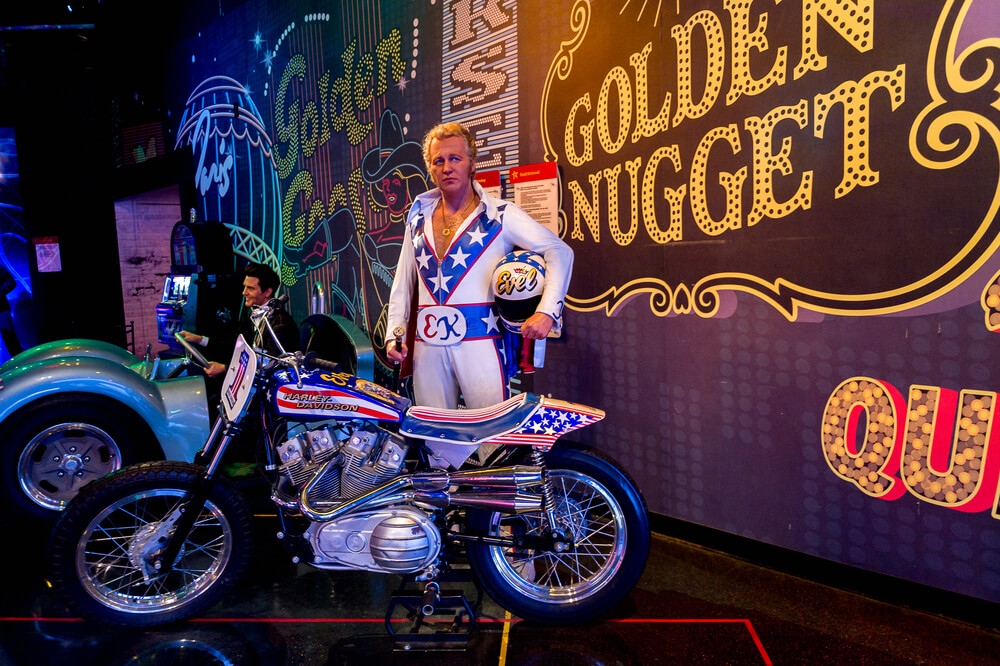It looks like the Evel Knievel Museum might be moving to the arts district in downtown Las Vegas. Rumor has it that Las Vegas developer J Dapper and Jonathan Kermani, owner of 1001 S. 1st Street, plan to bring the museum here from Topeka, Kansas.
However, museum marketing director, Amanda Beach said, “The deal is not completely finalized. But, we are looking forward to the possibility of what could happen. The Evel Knievel museum deserves to be a major tourism destination. I don’t think anyone can argue that Las Vegas makes sense as the home of the Evel Knievel Museum, considering Evel’s history there.”
The Topeka-based museum was founded in 2017 to gather and conserve authentic artifacts from the daredevil’s career. The intent is to preserve for future generations the cultural impact Evel Knievel had on the generation that grew up in the 1970s.
Evel Knievel Museum Won’t Jump to Vegas Right Away
Information released by the museum indicates the move won’t happen immediately; rather, the jump to Vegas could happen over the next few years.
Topeka officials were surprised at the potential move, noting that the museum attracts 40,000 visitors to the city each year. The midwestern city stands to lose tourism dollars and is working with the museum to see what could fill that void.
The 13,000 square foot Evel Knievel Museum in Topeka features Evel’s motorcycles, and his iconic wardrobe and jewelry. Best of all, visitors can experience a virtual reality jump simulating the legendary daredevil’s historic rides.
Evel Knievel, 70s Pop Icon
Like other iconic pop figures of the 1970s, Knievel was known for his flashy, leather jumpsuits; in fact, the daredevil’s wardrobe was often compared to that of Elvis Presley and Liberace.
Knievel said that the reason for the flamboyant costumes was because he understood Liberace was not just a performer, but the ultimate showman. The costumes were one way that Knievel could enhance the showmanship of his jumps.
Knievel varied his leather jumpsuits to align with his current sponsors; for example, when he rode a Triumph, his white, leather jumpsuit had stripes on the sleeves and legs. Then, in 1969, when he began riding a Laverda motorcycle, he switched to a white jumpsuit adorned with the rebel flag.
Each new jumpsuit would be more elaborate, including things like a huge, Elvis-esque belt buckle, or a short, red-white-blue cape. In 1975 for the Wembley jump, Knievel rode wearing blue leather adorned with red stars on white stripes.
Of course, Evel Knievel did not become a pop icon for his wardrobe alone; along with his red, white, and blue leathers and his Harleys, his audacious, do-or-die will to succeed embodied the American Spirit.
Growing up in the rough and tumble mining town of Butte, Montana, Robert Kraig Knievel was a thrill-seeker from a very early age. He credits the Joie Chitwood Auto Daredevil Show, for inspiring his daredevil career at the age of eight.
Born in 1938, Knievel spent the first few decades of his life, drifting from job to job, and landing in and out of jail. But along the way, he indulged in performing daredevil stunts; for example, while working the mines in Butte, he popped a wheelie with a piece of heavy equipment. Unfortunately, that stunt ended on top of a generator, taking leaving the town without power.
A Pop Icon is Born
During the mid-1960s, while working at a motorcycle, shop, motorcycle racer Jim Pomeroy showed Knievel how to pop a “wheelie”. Pomeroy also taught Knievel how to ride a motorcycle while standing on the seat.
That was it for Knievel, he had found his calling.
His first motorcycle stunt was jumping over a twenty-foot-long, rattlesnake-filled box and two mountain lions. Knievel barely made it over, but he did manage a safe landing.
From there, the stunts only got bigger and badder. But it wasn’t just the jumps that gained Knievel notoriety. He also became famous for narrowly escaping death. For example, in 1967 Knievel jumped the fountains at Caesar’s Palace in Las Vegas. He made it over the fountains, but the stunt with a crash landing.
Knievel suffered a crushed femur and pelvis, hip fractures, and fractured wrist and ankles. But that wasn’t the worst of it; he suffered a concussion that left him in a coma for a month. It wasn’t only the stunts that kept his fans spellbound, it was also whether or not he would make it out of the hospital.
Perhaps his most famous stunt was the jump over the Snake River Canyon in Idaho. Knievel had planned on jumping the Grand Canyon, but the parks service stopped him. He succeeded, narrowly avoiding a fall into the steep canyon, and drowning in the turbulent Snake River.
Moving the museum to Las Vegas will remind visitors from all over the world of the one-of-a-kind, real-life American action figure.

